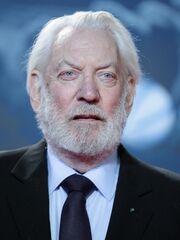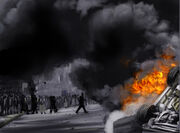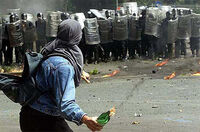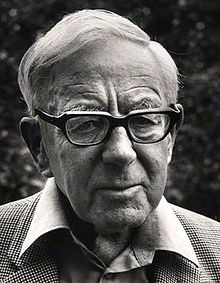| This article, 2554 New Canadian Revolution, was written by slowfuture. Please do not edit this fiction without the writer's permission. |
| A revolution so unlike all others, a revolution designed not to benefit a minority of zealots, a revolution to knit together the intricate web of a dissatisfied populace. A revolution that helped people to realise that communities were more than simply cultural similarities.[1] |
- "Ash-shaʻb yurīd isqāṭ an-niẓām/The people want to bring down the regime"
- ―Common mantra throughout the colony
The 2554 New Canadian Revolution was an unprecedented series of protests, both violent and non-violent that took place in the colony of New Canada. These protests were part of the 2554 Mid-Rim Protests. The New Canadians took to the streets with the intention of removing the emergency laws that had been in place since the beginning of the war and as the economy was still in a continuing state of total war. The protests were noted for the general lack of intervention by the devastated UNSC. At the beginning over the revolution, the protesters had no intention of removing the colonial governor—Ben Ali—from office. But as the government became more and more heavy handed in their approach to stopping the protests, the goal shifted into removing all vestiges of the regime that had ruled perpetually and unopposed for twenty-seven years. Many agree that the catalyst for the Mid-Rim wide protests were the 2553 Martian food protests which took place at the heart of the surviving UNSC's empire; this protest met with incredible success - over-turning of many War based policies.
Background[]
Motivation[]
The war with the Covenant had been all-consuming and had forced the economy of the UNSC to be solely focused on war production creating a state of total war. The United Earth Government's dominance in its original political role was slowly being superseded by that of the UNSC’s military role – soon the two became indistinguishable as the UNSC absorbed the last vestiges of the UEG’s old power. It became apparent to those at the top of the pyramid of power that it would soon become much too difficult to maintain effective administration of the colonies from Earth. As such, in 2535, the UNSC devolved a series of powers to the colony worlds they still held. It allowed the colonies to administrate their own fiscal and economic policy within a certain spectrum. Each colony was allowed to determine what it contributed to the war effort, and that was it - the economy was forced to be based on war production which left a general feeling of disdain in the ordinary people who were forced into making draconian cuts to their lifestyles. On top of that, each colony was allowed to create its own militia forces from those who were in the armed forces. When it became clear that the Mid-Rim worlds were not going to be attacked by the Covenant, many leaders enacted emergency laws that curbed civil liberties and strengthen their position of power. Propaganda was used to help solidify the position of the emerging despots. It was stated that what they were doing was in the best interests of the people, the war effort and the UNSC. Civil strife was at a minimum and life went on as best it could in the times.

President Ben Ali - colonial governor of New Canada
However, when it became clear that the war would be won—news reached the Mid-Rim of the Sangheili fleet helping the stricken Home Fleet arrived a fortnight after the beginning of Raid of the Ark. Murmurings began as people questioned the need for the strictness of the colonial governments' control over the people. Many called for fresh, democratic elections as many of the ruling parties had been in office for the duration of War. The governments urged caution and patience from their populace. They argued that it was too soon after the war to begin the transition back towards democracy as they had yet to receive official word from the government on Earth of the end of the war and, on top of that, they had to allow the economy to wind down from total war and allow its transition into other areas of growth and development begin. This did much assuage the fears of most of the civilian population throughout the Mid-Rim. However, the rulers of the Mid-Rim were shocked by the sudden outcry and took steps to strengthen its grip on the colonies. A conference, styled as the 'Mid-Rim Gathering' was held, all of the leaders of the colonies met and came together discuss trade issues. Though in secret, a pact was created. They agreed that should one of the colonies suffer a protracted case of civil resistance, the other colonies would come to its aid. This pact led to the passing of a series of secret legislation that effectively turned the colonial governor into a dictator. Strikes and unions were banned and new political parties were forbidden from being formed. While political opposition was allowed, it was severely limited in what it could do. Censorship was strengthened and it was now illegal for any publications to openly criticise the governments. Elections were held, but they were rigged and monitored by state officials and throughout the Mid-Rim the pro-regime party—Coalition for Mid-Rim Stability (CMRS)--was returned with a vast majority.
The obvious curtailing of civil liberties had the precipitating effect of causing widespread discontent amongst the intelligentsia. They were most open in their criticism of the new policy direction from the government. They began to whip up discontent among the middle-class and the working class. Anti-Government propaganda was circulated in the work places that demanded the creation of unions. Many unions were created as a wave of anti-government feeling swept through the Mid-Rim and strikes were held in the manufacturing sector as well as among disillusion civil servants. The government sent in troops to disperse the striking workers, when they refused to move the leaders were rounded up and imprisoned without trial. This was a fool move by the governments, who were working in unison as they all faced the same problems, and it led to an even great resurgence in anti-government sentiment. Strikes turned into protests as millions marched demanding more democratic freedoms as well as the release of their imprisoned leaders.
Though political reasoning was a big factor in the motivation of the protesters, it was not the only factor. The state of the economy also played a large part in shaping people's feeling toward the government. The state of the economy in the colonies was grim. Each colony had almost exhausted its resources with its part in the war effort. After the war ended, there were massive lay-offs in the manufacturing industry as it was now unsustainable to keep on the surplus of people required to fit the quota tasked to the colony. As a result of this, unemployment in the colonies stood at a staggering 35% of the available work force. The colonial governments were unable to do much to rectify these problems as they themselves were in significant debt. The civilian population began to see the ruling elite to be unskilled and unsuitable to lead the colony and what's more - many people thought the government apathetic to its people's suffering.
The Martian Dimension[]

Riots in the Seven Hills suburb on Mars.
It was widely accepted that the majority of the population of the Mid-Rim colonies knew of the Martian Food Riots that had taken placed immediately after the war had ended. The people of Mars had taken to the streets demanding an increase in their food rations as most of the population were close to starving. The Martian government were unable to satiate the demands of its people and as a result, the people began to rise against the government. The protests, which had started as apolitical, became more and more political in nature as the demanded greater freedoms from the grip the government had on the population and, indeed, from the crippled UNSC itself. Fortuitously, the protests remained largely non-violent as there was a great spirit of brotherhood between the people and they did not wish to see human bloodshed, especially after the horrors of the past twenty-eight years. Though that is not to say that there wasn't violence - rioting broke out, but it remained largely confined to the capital and as such causalities on both sides—civilian and pro-UNSC—remained low: fewer than three hundred people were killed during the eight month long riots. The riots were largely successful as rationing was loosened and fresh elections were held - the Martian people set a precedent for the rest of the surviving colony worlds.
The non-violent nature and the considerable rapidness of the success of the Martian protests inspired the repressed Mid-Rimmers into action. They took direct inspiration from the Martian tactics of civil disobedience against the ruling party. There were many tales told of how the United Earth Government had not been heavy handed in its attempts to quell the rebellion, instead it had taken the prudent decision to listen to the concerns of the people and address the issues where they could while also promising to address the others whenever it could. Many people in the Mid-Rim worlds believed the same would be applied to them and as the protests began, there was a degree of optimism that had not been in the colonies since before the war.
The Revolution[]
Overview[]
Many people did not suspect that the 'politically sleepy' New Canada colony world would ever rise up against its government any shape or form that it did. Indeed, this was not a conjecture without sufficient evidence. In the years immediately prior to the Human-Covenant War, the New Canadians had stated in a colony wide poll that they were very satisfied with the UNSC and how their colony was being run — a staggering 93% of people polled that they would not change a thing about their colony. So when the uprising began, it dumbfounded many of the species' top socio-anthropologists and political scientists. Their surprise, however, was not surprising. The UNSC had effectively been forced to withdraw all its naval presence in and around the Mid-Rim colonies -- to which New Canada belonged -- in 2542 and as such were unable to fully grasp the steps Ben Ali was taking to keep himself in power beyond his time and creating a dynasty from which his name would always been the ruling name of New Canada. As such, the UNSC was unaware of the growing discontent in the colony. Their monthly transmissions which were made to keep on top of the shipments of the high quality raw materials that the UNSC so desperately needed did not give off an impression of unhappiness within the colony. Though had the UNSC gotten a whiff of discontent, it is unlikely they would have done anything as they simply did not have the resources to defend and micromanage what was now a distant colony.
New Canadian Revolution[]
- "When a government ignores its people, the people deserve to ignore its government!"
- ―The New Canadian Chant.

Rioting in the Capital.
The New Canadians had been waiting patiently since March for its government to repeal the emergency laws that had been in place since the Human-Covenant War had been officially declared. These laws significantly reduced people's civil liberties and restricted their movement throughout UNSC space. While it was accepted during the time of total war, it confused people after its continuation after the war had ended. They saw it as superfluous and an attempt by the colonial government to take advantage of the weakened UNSC. If anything, the opposite happened. When the New Canadians at first dissented, the government showered them with platitudes and promised loosening of restrictions, instead, the government tightened the noose around its populace in conjunction with the other colonies of the region. The intelligentsia were disgusted at this action and stirred up dissent among the proletariat. Unions came out and ordered a general strike across the planet - with much success. The colony effectively shut down - many of the regional governments came out in support of the strikes. Those that did were rounded up by the state-funded militia. They were not the only ones who were rounded up, many of the leaders of the strikes were arrested too and imprisoned without charge. This led to an uproar among the local populace who continued with the strikes. The government was unsure of how to tastefully handle the volatile situation. They decided that the best action was to send in the colonial military to break up the strikes. This had an adverse effect. The military was not prepared for the situation they found themselves in. When the Nova Scotia regiment opened fire on strikers, a riot broke out in the region that left twelve dead.
The riots soon evolved into full-scale protests throughout the colony. These strikes were not organised and were only organised by word of mouth after the government brought down the cellular phone service. The fact that any protests took place was a testament to the desire of the New Canadians to do something to bring down the government that had become so corrupt. It was during this time the chant of Ash-shaʻb yurīd isqāṭ an-niẓām was first heard—which became the calling card of many the region, and also their own personal slogan came about. The protesters camped out in front of the capital buildings of every region in the colony. The government tried its best to maintain its power, but it was slowly slipping from their grasp. Ben Ali's cabinet resigned and joined the protesters - he was alone in a sea of discontent. He quickly realised that he had lost his power and made secret arrangements to leave the colony and find shelter in a different world in the region. During the night of October 13, he left the Capital on board a pelican and embarked on a New Tunisian corvette that took him to New Tunisia to start his new life. The impromptu, disorganised and chaotic revolution had brought down a well-entrenched colonial government. The rest of the region looked on in awe and wished to emulate the New Canadians.

A placard that reads: "Ben Ali - Out."
A series of political changes were made after the Revolution ended three days after Ben Ali's resignation on October16. It was decreed that the New Canadian Colonial Assembly was to become a bicameral body, replacing the unicameral system that had been in place. The lower chamber became known as the Chamber of the People as was democratically elected by universal suffrage, while the upper chamber became known as the Chamber of the Wise - this was to be half elected by the people, once again, under universal suffrage and the other half was to be appointed by the President and his Cabinet based on suggestions made both by the lower house and the people through special plebiscites. It was also put into law that both chambers of legislature must represent the 'complicated and diverse population of the Colony of New Canada.' As such this meant that in both houses around 52% were of French descent, while 40% were of Arabic descent and 8% were of Spanish/Portuguese descent. As well as this, it was stated that the president must be French, the leader of the lower house must be Arabic and the leader of the upper house must be Spanish. This was purely symbolic as the power resided with the cabinet government which also reflected the population of the colony. The Supreme Court was made up six elder statesmen. It was required that those who wished to become members of the Supreme Court, and indeed the judiciary, renounced all political aspirations and safe-measures were put in place to oust judges who became too political. Each community took one-third of all positions on the Supreme Court. Another requirement for who those who wished to become Supreme Court Judges was that they must be over the age of fifty-five and have had at least twenty years of experience in the court system. The judiciary was totally separate from the Executive body and was unable to stop bills being passed; its only political power was the ability to make a 'declaration of incompatibility' against bills that went against the constitution.
The Revolution also had a healing and unifying effect on the New Canadian community. New Canada had around a half-way split between people of Arabic descent—which was true for the vast majority of the region—specifically Tunisian, and people of European descent; ranging from both France and the Iberian Peninsula. As such Sunni Islam and Roman Catholicism were the two largest religions present on the colony, there was a general distrust between the two communities throughout the time before the Revolution. There was very little in the way of racial mixing - it was possible to find small town and village communities that were entirely composed of one section of the community. Though in the larger towns there was some mixing between the races, but limited; most of the communities tended to stick to their districts. It was only the Capital of New Canada, جديد قرطاج (Qarṭāj) or Nova Karthago, that any real in roads had been made into racial and religious integration. The Revolution brought what was an otherwise fractious existence into harmony. After the Revolution, community leaders came together for the first time to discuss what should be down to bring the colony back on to its feet. It was also agreed more must be down to bring the people of the colony together - a new motto was proposed for the new leaf the colony was about to turn: Prosperity through Inclusion.
Historical Interpretations[]
As the revolutions were so unexpected and happened so suddenly, it has become difficult to understand exactly why they took place at all. There have been many interpretations as to why they occurred, ranging from the mundane to the absurd. Though in time, two main schools of thought have gained prominence in their approach: The Whig Interpretation and the Marxist.
Whig & Marxist Interpretation[]

Percivale Taylor - the leading Marxist historian of the time.
The Marxist Interpretation was first espoused by historian Percivale Taylor in his book New Canada - The Proletariat Revolt, (2578). Throughout the book he states that the revolution took place because of the general ebb of discontent felt by the working class at their 'betters', as he puts it. The working class was seeing the benefits that the bourgeoisie had been receiving during the war, as such; the working-class began to demand that more was done to improve their lot as they had to queue for hours to get even the most basic of rations. When it became clear to the Working Class that government was not going to do anything to help, they decided to go on strike to make their lives better for themselves – “God will help those who help themselves,” became the working classes slogan. They took to the streets demanding better wages, and when the government sent in troops to put them down, the strikes became more and more political and eventually came to demand the resignation of Ben Ali and his entire government. Taylor states that it was because of Ben Ali’s lack of interest in shifting away from the economy's dependence on the manufacturing sector that led to the feeling of discontent among the working class, as it caused several labourers, highly skilled in other fields, to remain unemployed, as well as keeping the private sector’s growth minuscule.
However, this view is not widely accepted and many see it as too simplistic. Critics note that lack of consideration to the middle-class intelligentsia that began to rile up discontent among the working class. The middle class was the first group that sniffed the beginnings of corruption. To Whig Historians, this is seen as a desire for a more enlightened way of governing. This idea of the revolution was first brought to the fore by Eddard Gibbon in his book The Enlightened Revolution. (2582) In it, he states that the intelligentsia realised that the colony was well on its way to civil war because of the distrust between the two main ethnic groups. Gibbon believes that the aforementioned intelligentsia wanted to heal the wounds of the two communities—as proven by the projects that took place after the revolution—he also believes that the best way to do this was to bring the communities together in large strikes which would allow them to mingle and share their ideas for the future of the colony.
Once again, this is seen as too simplistic by other historians, as Gibbon does not take into account the regional integration projects that had taken place in some regions; indeed Gibbon completely ignores the Nova Scotia region which had brought community leaders together to discuss better ways of inclusion. Most agree that it was a culmination of factors that led to the revolution. Though Gibbon’s interpretation has achieved more credibility than Taylor’s; which was seen as pandering to the rise of the Socialist Party on New Canada which had achieved a plurality in the elections around the time of the writing and could trace its history to the unions of 2554. That is not to say that Taylor’s book has no significance, indeed, on the contrary, Taylor’s sources come straight from members of the working class who had taken part in the revolution and as such, the book is seen more as a sociological tour de force.
References[]
- ↑ Lijphart, Arend. The New Canadian Effect: how and why a safe government fell. 2nd Ed. Reach University Press, 2612

